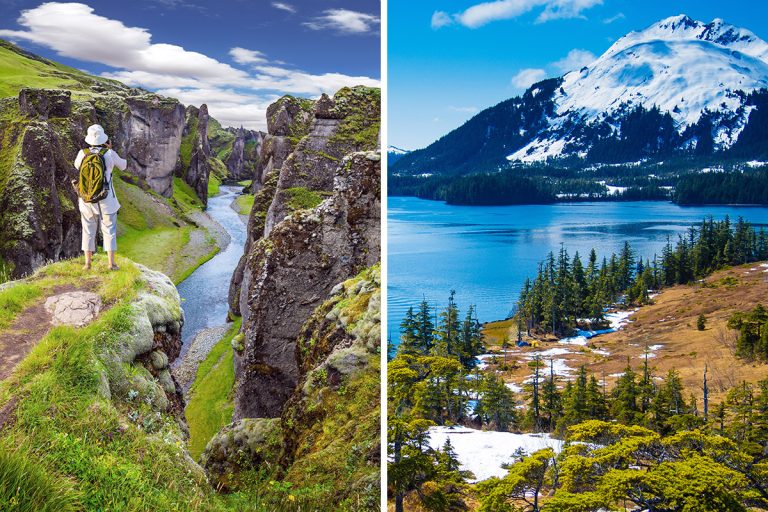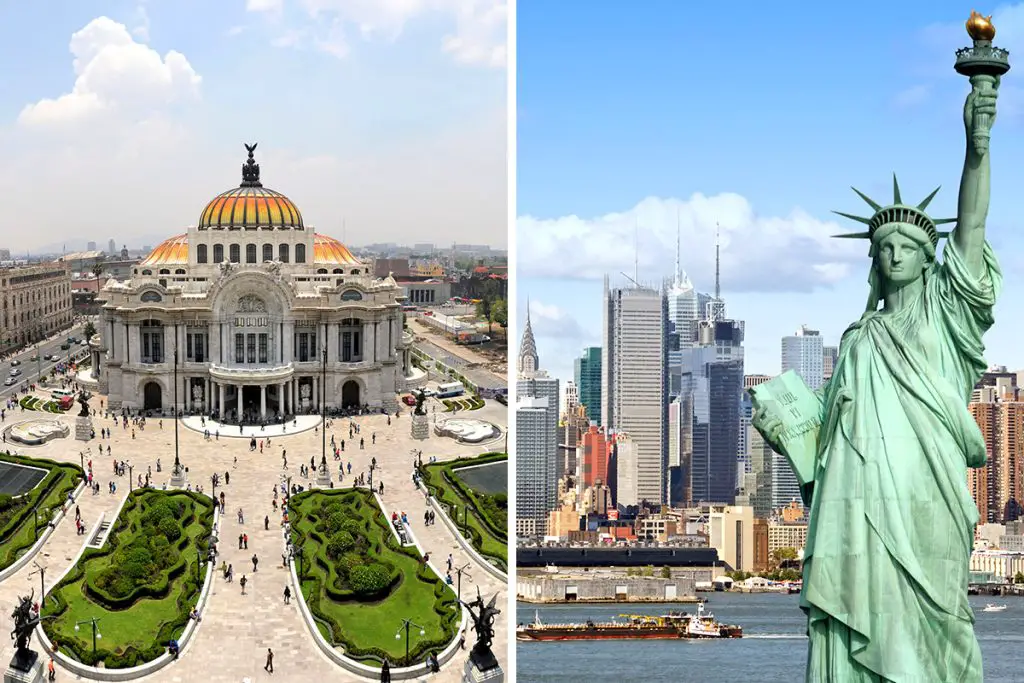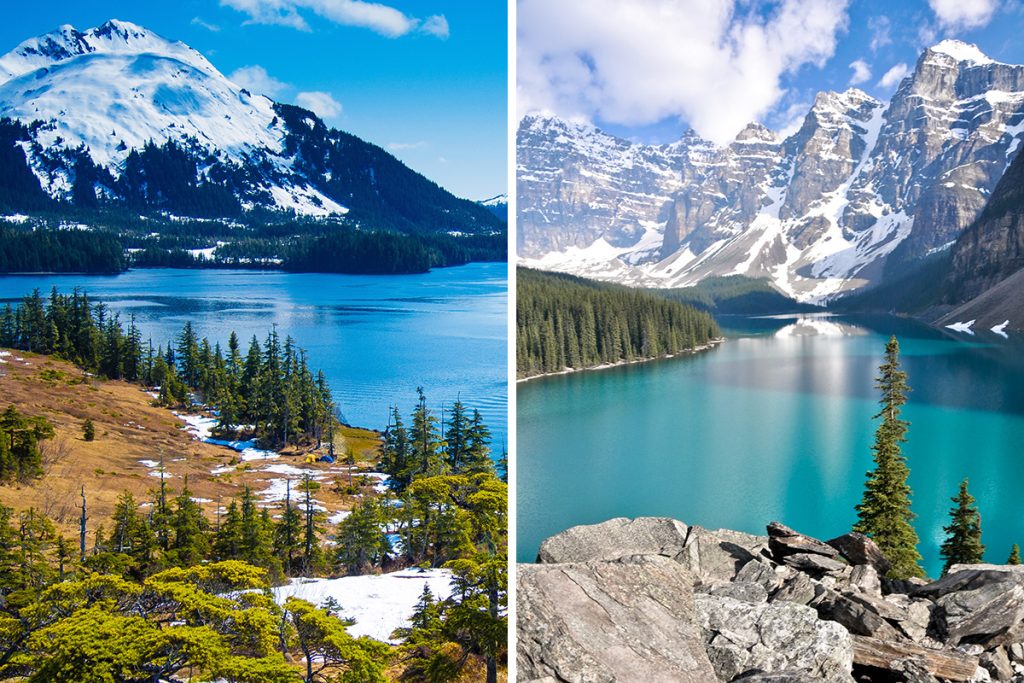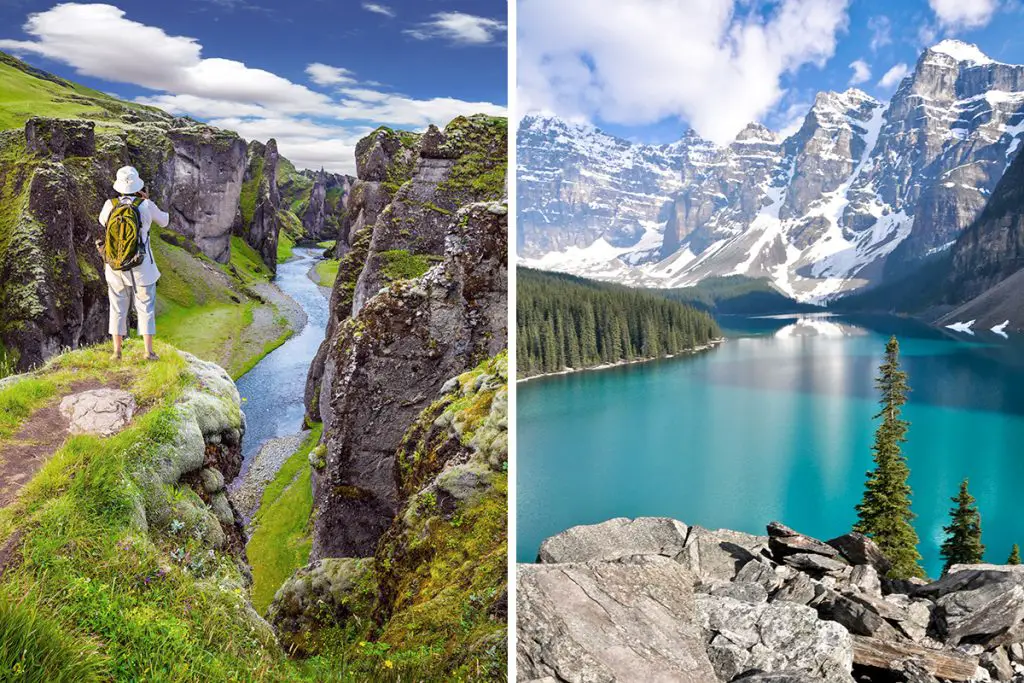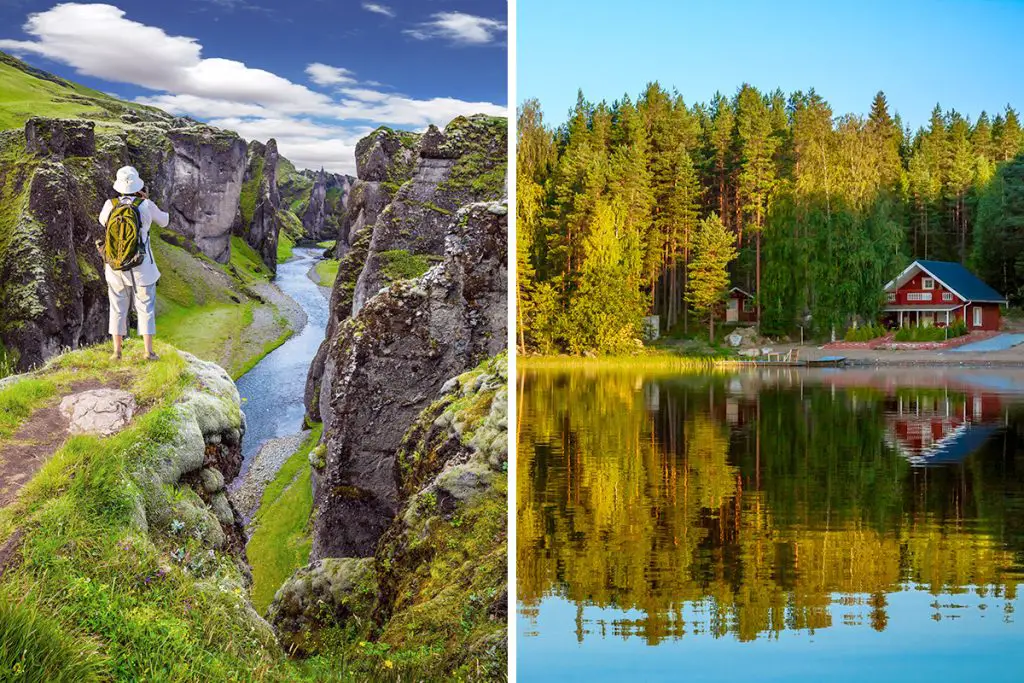Delving into the fascinating past and vibrant traditions of both destinations, you’ll be transported to a time of ancient sagas and age-old customs. From the Viking settlers of Iceland to the Native Alaskan tribes, every corner of these destinations tells a story. Ready to take this journey into the past? Read on, your adventure awaits.
History & Culture
Getting acquainted with the historical background and cultural nuances of Iceland and Alaska can help you appreciate the uniqueness of these places. It’s like opening a vibrant tapestry woven with stories of daring adventurers, intrepid settlers, and enduring indigenous cultures. Let’s uncover this tapestry.
In Iceland, history is deeply ingrained in the landscape, dating back to its settlement by the Vikings around the 9th century. The Icelandic sagas, epic tales of exploration, warfare, and heroism, are a testament to these early settlers’ resilience and spirit. This small island nation has a rich cultural heritage, with tradition and modernity interweaving seamlessly.
Literature and music play a significant role in Icelandic culture, while folklore, filled with tales of elves and trolls, has a charming presence.
On the other hand, Alaska has a unique history that is rooted in its native peoples. For thousands of years before the arrival of European explorers, the indigenous tribes of Alaska thrived, their lives intertwined with the harsh but beautiful environment.
The history of Alaska is a blend of native culture, Russian colonization, and American acquisition, each phase leaving its mark on the landscape and people. The rich indigenous cultures of the Aleut, Athabaskan, Inuit, Yupik, Tlingit, Haida, and Tsimshian continue to thrive, reflecting vibrant traditions, art, and storytelling.
In comparing Iceland and Alaska, it’s apparent that both destinations have a rich historical and cultural tapestry.
Where Iceland boasts a Viking heritage and a love for sagas, Alaska has a blend of cultures resulting from its indigenous roots and periods of colonization. Their cultures are distinct yet similar in the sense that both places have a deep connection with the land and the environment.
In summary, choosing between Iceland and Alaska isn’t just about the views. It’s about embracing the fascinating history and culture that permeate every corner of these stunning destinations. So, will it be the Viking tales of Iceland or the indigenous cultures of Alaska that call out to you? Only time will tell!
Attractions & Activities
When it comes to breathtaking attractions and exciting activities, both Iceland and Alaska offer an abundance of options. In both places, the vibrant landscapes set the stage for unforgettable experiences. Let’s dive into the unique offerings of each destination.
In Iceland, your adventures begin with majestic natural wonders. The Golden Circle route is a must-do, leading you to Thingvellir National Park, Gullfoss Waterfall, and Geysir Geothermal Area.
For a truly unique experience, venture inside Langjökull Glacier or take a boat tour in Jökulsárlón Glacier Lagoon. Don’t miss the opportunity to witness the Aurora Borealis, a natural light show that is sure to leave you spellbound.
As for activities, hiking is popular, with trails leading to scenic spots like Svartifoss waterfall or through Skaftafell Nature Reserve. Explore the natural beauty of the island on horseback or get a bird’s eye view with a helicopter tour. For those seeking a unique cultural experience, visiting the traditional turf houses or soaking in a geothermal pool are activities that you would enjoy.
Alaska, on the other hand, boasts towering mountains, sprawling forests, and incredible wildlife. Denali National Park, home to North America’s highest peak, Mt. Denali (20,310 feet or 6190.5 meters), offers hiking, wildlife viewing, and mountaineering opportunities.
The Kenai Fjords National Park is perfect for glacier and wildlife cruises, while the Northern Lights can also be viewed in the state’s interior and northern regions during winter.
In terms of activities, you can venture into the wilderness for bear watching or go whale watching in the southeast. A visit to historical towns like Skagway or an adventurous trip on the Alaska Railroad can add an exciting dimension to your Alaska experience.
To summarize, both Iceland and Alaska are havens for those who crave outdoor adventures and stunning natural attractions. Whether you are gazing at Iceland’s powerful waterfalls or admiring Alaska’s towering peaks, these destinations promise an unforgettable experience.
Eating, Drinking & Nightlife
From the delightful flavors of local cuisines to the vibrant night scenes, the dining and entertainment experiences in both Iceland and Alaska can leave lasting impressions on visitors. Each destination has unique culinary traditions and nightlife that reflect their culture and lifestyle.
In Iceland, the cuisine is deeply connected to its maritime roots. Traditional dishes like “harðfiskur” (dried fish) and “hákarl” (fermented shark) can be a real adventure for your taste buds. However, contemporary Icelandic dining also shines, with Reykjavik offering a range of sophisticated restaurants serving local ingredients in innovative ways.
When it comes to drinks, Icelanders have a fondness for their local beverages. From Brennivín, often referred to as “Black Death,” a type of schnapps, to a variety of craft beers from local breweries, there’s plenty to sample.
As for the nightlife, Reykjavik is known for its surprisingly lively scene. The compact city center is home to a number of clubs, bars, and live music venues. Keep in mind that things heat up late, with many locals starting their night out well past midnight.
On the other hand, Alaska’s food scene is characterized by its wild-caught seafood and game meats. From succulent king crab to smoked salmon and reindeer sausages, the local fare is a testament to its rich natural resources.
As for drinks, Alaskan craft beer is well-respected, with numerous breweries offering a wide selection of locally brewed ales, lagers, and stouts. Sipping on a glass of locally distilled spirits or enjoying a glass of birch syrup cocktail can be a memorable experience.
Nightlife in Alaska varies from city to city, but it tends to be more low-key compared to Iceland. Anchorage offers a variety of bars and clubs, while in smaller towns, the local bar can serve as the main social hub.
To summarize, whether it’s diving into traditional Icelandic fare and buzzing nightlife, or savoring Alaskan seafood and enjoying a laid-back evening, both destinations offer distinctive experiences that cater to a variety of tastes and preferences.
Shopping
For those who enjoy hunting for unique finds and local treasures, the shopping scene in both Iceland and Alaska can be quite appealing. These destinations offer a wide range of local products and crafts that reflect their cultural heritage and natural resources.
In Iceland, the capital city of Reykjavik is a shopper’s delight. From Icelandic wool products like “lopapeysa” sweaters to beautiful handmade ceramics, there are many items that capture the essence of Icelandic culture and lifestyle. Also, don’t miss the chance to check out local music records or books by Icelandic authors.
On the other hand, Alaska offers an array of indigenous crafts and locally made goods. You can find intricately carved totem poles, handwoven baskets, and beaded jewelry that reflect the artistry of Alaska’s native tribes. In addition, gold nugget jewelry, wild berry products, and Alaskan smoked salmon are popular souvenirs.
In summary, both Iceland and Alaska offer a shopping experience that goes beyond the typical. You can discover unique cultural artifacts, local crafts, and products that are deeply intertwined with the land and its people. So, will it be the warm woolens of Iceland or the native crafts of Alaska that you’ll take home as souvenirs? Your shopping adventure awaits!
Accommodation
Accommodation is a crucial part of any travel plan, and both Iceland and Alaska offer a broad range of options, each with its unique charm. Let’s delve into the lodging scenes of these two adventurous destinations.
In Iceland, your choices range from modern city hotels in Reykjavik to charming rural guesthouses and farm stays across the country. Boutique hotels and luxury resorts offer spa treatments, gourmet meals, and stunning views of the surrounding landscapes. For more budget-friendly options, there are hostels and campsites, particularly popular among summer travelers.
On the other hand, Alaska provides diverse lodging experiences. Luxury resorts and lodges offer top-notch amenities, often with breathtaking views of mountains or water. Cabin rentals and bed-and-breakfast establishments provide a more intimate, homely feel. Additionally, for the more adventurous, camping in state and national parks brings you close to Alaska’s natural beauty.
In summary, whether you fancy a high-end resort, a cozy guesthouse, or a spot for camping under the stars, both Iceland and Alaska cater to every preference and budget. It’s all about what suits your comfort level and your idea of an ideal vacation base.
Family-Friendliness & Children’s Activities
Traveling with family is a joyous experience, and both Iceland and Alaska are ideal destinations for a family trip. With diverse activities for kids and a welcoming atmosphere, these places ensure a memorable family holiday.
In Iceland, families can explore the country’s stunning landscapes with child-friendly activities like hiking shorter trails, visiting animal farms, or exploring lava tubes. The geothermal pools are a hit with kids and the perfect place for the whole family to relax. Cultural centers and museums with interactive exhibits also provide educational fun for children.
Alaska is equally welcoming for families. Activities like wildlife viewing tours, dog sledding, and visiting places like the Alaska SeaLife Center or the Alaska Wildlife Conservation Center are great for children. The state’s numerous parks offer educational ranger-led programs, adding an enjoyable learning dimension to your child’s vacation.
In a nutshell, both Iceland and Alaska provide a family-friendly atmosphere with numerous activities to keep your little ones engaged and entertained. Whether it’s learning about Vikings in Iceland or getting up close with Alaskan wildlife, your family is sure to create lasting memories.
Getting There & Getting Around
Embarking on a journey to either Iceland or Alaska is an adventure in itself. How you reach these destinations and navigate through their spectacular landscapes can significantly impact your overall travel experience.
Reaching Iceland is fairly straightforward. Most travelers fly into Keflavík International Airport, which is about 31 miles (or 50 kilometers) from the capital, Reykjavik. Numerous airlines offer flights from many cities around the world.
In contrast, reaching Alaska can be a bit more complicated. It’s a large state, and where you land depends on your itinerary. Anchorage, the largest city, has the busiest airport. However, there are also smaller airports in towns like Juneau and Fairbanks. Some travelers even opt to arrive by sea on a cruise ship!
Once in Iceland, the easiest way to get around is by renting a car. The country’s main road, Route 1, circumnavigates the island, making it simple to explore. Bus service is also available, but it can be limited, especially in remote areas.
Getting around Alaska involves a mix of driving, flying, and sometimes even boating! Car rentals are available in major cities, and the Alaska Highway offers an epic road trip. However, given the state’s size, you might need to take internal flights or ferries to reach certain places.
In conclusion, whether you’re planning to chase waterfalls in Iceland or witness the grandeur of Alaskan wildlife, understanding your transport options is key. Whether by land, air, or sea, the journey is all part of the adventure.
Weather
Weather often plays a big role in shaping your travel experience. Both Iceland and Alaska, located in the northern extremes, provide a unique climate perspective that you’ll want to consider when planning your trip.
Iceland, despite its name, has milder weather than you might expect. The Gulf Stream warms the island, leading to relatively mild winters and cool summers. Average winter temperatures hover around freezing, 32°F (0°C), while summer temperatures reach averages of about 55°F (13°C).
The best time to visit is from June to August, when the weather is the warmest and the famous midnight sun occurs.
On the other hand, Alaska’s weather varies widely depending on the region. Coastal areas have milder winters and cooler summers compared to the interior. Winter temperatures can plunge as low as -20°F (-29°C) in the interior, while coastal areas stay around 20°F (-6°C). In summer, temperatures range from 60°F (16°C) in coastal areas to 80°F (27°C) in the interior.
The most popular time to visit is during the summer months from June to August.
In conclusion, both Iceland and Alaska offer unique weather experiences. Whether you want to enjoy the midnight sun in Iceland’s mild summer or marvel at Alaska’s more extreme temperature range, understanding their climates will help you plan for the adventure of a lifetime.
Safety
Safety is paramount when traveling. Rest assured, both Iceland and Alaska are considered safe destinations, each with their unique safety considerations.
Iceland is regularly ranked as one of the safest countries in the world. Violent crime is rare, and incidents involving tourists are uncommon. However, the country’s rugged terrain and unpredictable weather can pose risks. Always follow weather forecasts and hiking advisories to ensure your safety.
In Alaska, crime rates vary by region, but generally, it’s a safe place for tourists. Like Iceland, the main safety concerns are related to the great outdoors. Wildlife encounters, particularly with bears and moose, can pose dangers. Always respect wildlife guidelines, keep a safe distance, and store food properly.
One unique aspect of safety in these destinations is the potential for seismic activity. Both Iceland and Alaska are on active tectonic plates, meaning there’s a potential for earthquakes or volcanic activity. Though these events are typically rare and monitored closely, it’s always good to be aware and heed any official advisories.
To sum up, while both destinations are generally safe, being aware of environmental factors is key. With a little caution and respect for the great outdoors, you’re set for a safe and memorable trip.
Cost
Understanding the cost is an important part of planning your travel. While both Iceland and Alaska offer experiences of a lifetime, their costs can vary.
Iceland is known for being on the pricier side. Accommodation, eating out, and popular activities like glacier tours or whale watching can add up. For instance, a meal at an inexpensive restaurant might set you back around 2,500 ISK or $20.
On the contrary, Alaska can be a bit more budget-friendly, though it still isn’t cheap. Costs can vary widely depending on your choices of accommodation, dining, and activities. A similar meal might cost around $15.
Transportation can also factor into your budget. Car rentals in both destinations can be quite high, and gas prices in Iceland can be steep. In Alaska, you may have to factor in costs for ferry rides or internal flights due to its vast size.
In summary, while both destinations offer priceless experiences, they do come with their own price tags. Being aware of potential costs in Iceland and Alaska can help you plan a trip that fits your budget and still delivers on adventure and beauty.
Which Is Better – Iceland or Alaska?
When it comes to choosing between Iceland and Alaska, your decision ultimately comes down to what you value most in your travel experience. Both offer unique histories, breathtaking landscapes, and unforgettable activities, albeit with some differences.
In terms of history and culture, you might lean toward Iceland for its rich Norse heritage and unique cultural traditions like the winter “Yule Lads” celebration. On the other hand, Alaska’s indigenous history and living traditions offer a compelling narrative that weaves together both past and present.
When you consider attractions and activities, it really depends on what kind of adventurer you are. If you’re drawn to the ethereal beauty of the northern lights, hiking across glaciers, or watching a geyser erupt, Iceland is for you. Alaska, however, calls to those who dream of fishing in pristine rivers, exploring massive national parks, or even dog sledding.
Beach lovers might find both destinations less traditional. Iceland’s black sand beaches are a sight to behold, but you might be more inclined to enjoy Alaska’s rugged, rocky coastline if you’re into dramatic seascapes.
Foodies and nightlife enthusiasts might enjoy both destinations. Iceland offers a unique cuisine based on its Viking roots, while Alaska’s seafood scene is hard to beat. In terms of nightlife, both destinations offer unique experiences, whether it’s a cozy pub in Reykjavik or a rustic lodge in Anchorage.
When it comes to shopping, Iceland’s Reykjavik is a wonderland of creative boutiques and art studios, while Alaska offers plenty of opportunities to find locally made crafts and indigenous art.
As for accommodation, both destinations offer a range of options, from luxury hotels to cozy cabins. Family-friendly activities abound in both places, too, whether it’s exploring geysers and waterfalls in Iceland or spotting wildlife and fishing in Alaska.
Navigating around both Iceland and Alaska presents unique challenges and adventures. Whether you choose to drive around Iceland’s Ring Road or navigate Alaska’s vast wilderness by plane or ferry, it’s all part of the journey.
Weather-wise, you’ll need to be prepared for cooler temperatures in both places. While both are safe destinations, it’s essential to be aware of the unique environmental factors in each.
Finally, in terms of cost, you’ll find that Iceland tends to be pricier while Alaska can be more budget-friendly. However, both offer priceless experiences that are well worth any cost.
In conclusion, whether you choose the ethereal beauty of Iceland or the vast wilderness of Alaska, you’re bound to have an unforgettable adventure. The choice ultimately depends on your personal preferences and what kind of journey you’re longing to embark on. So, where will your next adventure be – Iceland or Alaska?

